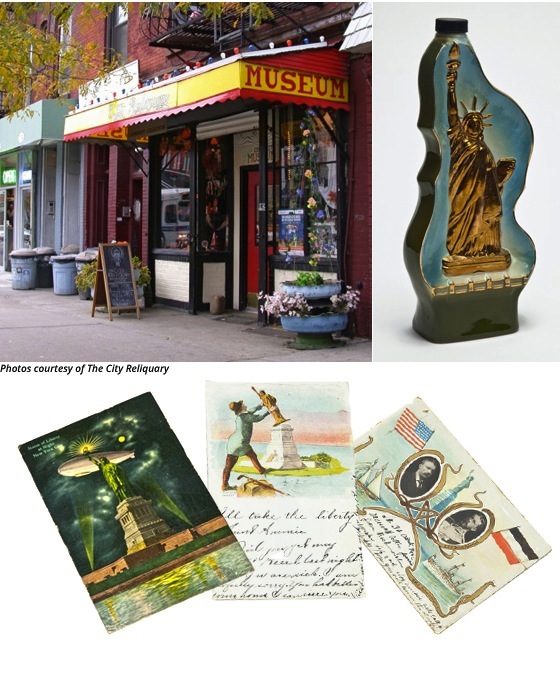
When Dave Herman moved into his ground-floor apartment at Havemeyer and Grand Streets in Williamsburg, he discovered a neighborhood in transition. Condos and high-rise apartment buildings were sprouting up in once barren lots; abandoned storefronts were transforming into upscale restaurants, cocktail bars, and yoga studios. Young creative types flocked to the area in droves. They set up loft spaces in the abandoned factories next to the homes of the established Hasidic and Hispanic communities. Dave saw the value in both the emerging scene and the traditions of the old neighborhoods. To connect Williamsburg’s rapid growth spurt and the area’s rich past, he dreamt up the idea of a
City Reliquary—a museum that celebrates Brooklyn’s evolution by immortalizing and honoring its history.
Dave started out simply, taking advantage of his apartment’s street-level windows to display his own family heirlooms and relics he salvaged from dumpsters and old buildings. Soon the windows were packed with oddities: a handbook to the 1964 World’s Fair passed down from his grandfather, a set of dentures found in Dead Horse Bay, a pair of prickly devils nuts purchased in Chinatown. When the collection grew too big for his apartment, Dave moved the museum to a storefront just a few blocks away.
Today, the museum is home to a permanent collection of New York City artifacts and rotating exhibitions of pieces from the local community. Each item tells a tale of the city's past—there's a three-tiered wedding cake display from La Villita, a historic and bygone Williamsburg Latino bakery. There's the barbershop chair that Barber Hall of Famer Antonio Nobile perched his clients in for nearly 50 years. There's the relic that guests have commonly come to refer to as the Very Old Shovel, an artifact unearthed from the Croton Aqueduct, which supplied the city with clean water for decades.
Dave maintains that he receives many of the museum's best ephemera from its visitors. Upon admiring the collection, museum-goers often remember a funky trinket or family heirloom they've been holding onto for years. "They suddenly feel a kinship with that object," Dave said. "They tell me, 'I never knew what to do with this, but now that I've seen your collection, I know it belongs here.'"
Parting Piece
The City Reliquary's gift shop is a spectacle in its own right, full of artwork and souvenirs from local artists. When asked to name a favorite gift-shop item, Dave reflected a moment before choosing a Brooklyn-shaped cutting board—from Brooklyn-based
A. Heirloom—that features a heart where the City Reliquary is located.
Still hungry for New York history? Dave recommends these spots:
Brooklyn Botanic Garden | Brooklyn
Founded more than 100 years ago, this 52-acre garden blossoms with bluebells, cherry trees, and roses in every color imaginable.
$10 admission.
New York Transit Museum | Brooklyn Heights
Set in the old Court Street subway station, the New York Transit Museum showcases vintage trains, wooden turnstiles, and station signs, along with multimedia exhibits devoted to the city's public-transit history.
$7 admission.
Queens Museum of Art | Flushing Meadows–Corona Park
Dave recommends the museum's
Panorama exhibit—a 9,300-square-foot architectural model of the city featuring all buildings constructed before 1992.
$8 suggested donation.
Lexington Candy Shop | Upper East Side
This old-timey soda fountain has been around since 1925, feeding hungry New Yorkers with juicy burgers, diner-style sandwiches, and thick malts.



 When Dave Herman moved into his ground-floor apartment at Havemeyer and Grand Streets in Williamsburg, he discovered a neighborhood in transition. Condos and high-rise apartment buildings were sprouting up in once barren lots; abandoned storefronts were transforming into upscale restaurants, cocktail bars, and yoga studios. Young creative types flocked to the area in droves. They set up loft spaces in the abandoned factories next to the homes of the established Hasidic and Hispanic communities. Dave saw the value in both the emerging scene and the traditions of the old neighborhoods. To connect Williamsburg’s rapid growth spurt and the area’s rich past, he dreamt up the idea of a
When Dave Herman moved into his ground-floor apartment at Havemeyer and Grand Streets in Williamsburg, he discovered a neighborhood in transition. Condos and high-rise apartment buildings were sprouting up in once barren lots; abandoned storefronts were transforming into upscale restaurants, cocktail bars, and yoga studios. Young creative types flocked to the area in droves. They set up loft spaces in the abandoned factories next to the homes of the established Hasidic and Hispanic communities. Dave saw the value in both the emerging scene and the traditions of the old neighborhoods. To connect Williamsburg’s rapid growth spurt and the area’s rich past, he dreamt up the idea of a 